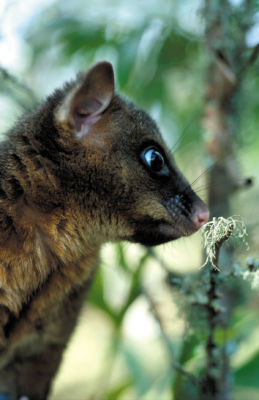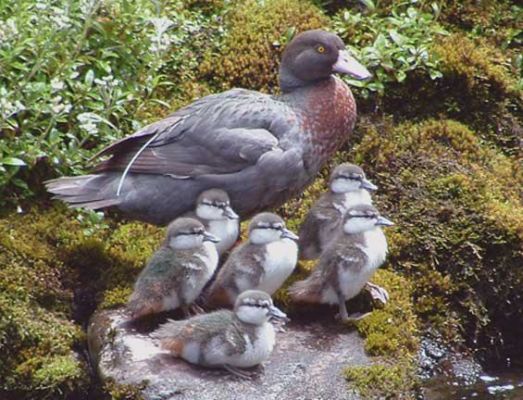Thermal squeeze: it’s what happens when temperatures rise, predators spread out to higher altitudes and their vulnerable prey species are squeezed into less-than-ideal pocket habitats at the outside edges of their range.

Like most predicted consequences of climate change, it’s not good news. So will it happen to New Zealand species? If so, what species are likely to be most severely affected? Is there anything we can do to prepare or mitigate for the challenges ahead?
Researchers Susan Walker, Adrian Monks and John Innes from Landcare Research investigated, and their report is currently ‘In Press’, due to be published in Biological Conservation in September and currently available online in draft form.

“We study the extant New Zealand forest avifauna, which has two non-independent key axes of threat – forest loss and predation by invasive mammals – and its most vulnerable species already severely restricted in distribution. The effects of invasive species whose ranges are expanding in response to climate change have the potential to drive a new wave of extinctions in vulnerable species. We explore whether expansion of mammalian predators in New Zealand will lead to the thermal squeeze of a forest avifauna by investigating the mechanisms that have led to recent declines.”
Ship rats and possums are two predator species likely to take advantage of warming temperatures to expand their ranges.
“Two important forest-bird predators, the Australian brushtail possum and ship rat (Rattus rattus), are more abundant in warmer, lower-elevation forest sites than in cooler forests. Densities of predators, including ship rats and stoats are low much of the time in cooler, floristically simpler forests dominated by beech or rimu, although predators do irrupt intermittently following synchronised heavy seeding of the trees. These patterns lead us to expect that predator-vulnerable forest bird populations would become progressively more confined to thermal refuges in cooler, higher elevation forests, and vulnerable to additional ‘thermal squeeze’ under a warming climate.”
The researchers evaluated what types of birds would be most vulnerable to thermal squeeze effects.
“To test our hypothesis that the threatened forest avifauna is especially vulnerable to a warming climate, we determine whether species changes through time along forest cover and predation axes of threat are explained by life-history traits. We selected a parsimonious set of three traits to indicate hypothesised mechanisms regulating persistence or local extinction, by way of:
- population responses to predation;
- dispersal;
- extent of forest habitat;
- productivity of forest habitat.
Body size
Our first trait, body size, was selected as an indicator of elevated extinction risk for three reasons. First, larger-bodied species have lower population densities, and low numbers of individuals bring increased risk of extinction through stochastic events. Second, larger-bodied species typically have longer generation times and other ‘slow’ demographic traits (e.g. few offspring, slow growth rate, late sexual maturity, long gestation. They are therefore less able to compensate for a sustained increase in annual mortality rate, such as imposed by novel mammal predation, and are driven to extinction more rapidly. Third, higher per-individual energetic needs mean that populations of larger-bodied birds are likely to require more extensive areas of habitat, or rely more on habitats with higher food resource productivity, which in New Zealand are also habitats that are warmer and that favour important bird predators.”
Cavity nesting
“We include cavity nesting as our second trait because it increases exposure to predation on the nest in New Zealand; although not always elsewhere; and is the strongest single predictor of total range decline across New Zealand’s extant forest birds.”
Low dispersal capability
“Our third trait, low dispersal capability, has been identified as a significant predictor of local extinction in the New Zealand avifauna and was selected to indicate low likelihood of recolonisation of sites following local extirpation. We expected low dispersal capability would compound higher probabilities of local extinction arising from large size and/or cavity-nesting in the face of deterministic predation and stochastic events.”
Hierarchies of vulnerability
“We therefore predicted that each of the three traits would compromise population persistence under higher pressure from predators, and would interact with gradients of mean annual temperature, forest cover, and time, giving rise to changing hierarchies of vulnerability. We expected populations of species that are larger-bodied, cavity-nesting, and weak dispersers (and therefore more vulnerable to declines under predation) to be most confined to cool, forested thermal refuges; continuing to decline more rapidly in warmer forests; and rare in or absent from warm deforested sites. We also expected that species with one or more of the three traits would be more restricted to cooler forests, and undergoing more rapid declines in warm forests, than species that have none of these traits.”
Bird Atlas data
Data on endemic bird distributions and declines which are already occurring were used to model various future scenarios. Previous, large-scale ‘Bird Atlas’ surveys carried out by the Ornithological Society (Birds NZ) were a key research resource for this analysis.
“Analysis of local occupancy across the three main islands between 1969–1979 and 1999–2004 shows that the ranges of predator-vulnerable endemic species are constrained by lowland forest loss and continued to contract to higher-elevation, colder parts of forested mountains.”
“Species that are large, nest in tree cavities, and/or disperse poorly have undergone more rapid recent loss where temperatures are higher, consistent with higher and more constant predation in warmer forested sites being the principal mechanism of recent decline. Warming climate is likely to exacerbate local extinctions of predator-vulnerable species by reducing the extent of cool thermal refugia from continuously high predation pressure below the upper limit of forest.”
The news isn’t all bad, however. Other endemic species are likely to be less affected.
“Warming is unlikely to jeopardise small-bodied, non-cavity-nesting, mobile species, which have had stable or increasing populations in warm sites and largely deforested landscapes.”
Hawai’ian similarities
We’re not alone in facing the challenges of thermal squeeze. The islands of Hawai’i are facing similar issues.
“New Zealand will share with Hawai’i the phenomenon of thermal squeeze of endemic forest bird species that is mediated by the changing range of an invasive species, rather than by native species themselves tracking their climatic niches. The environmental pattern of avian declines across New Zealand strongly resembles that in Hawai’i, where endemic forest bird populations initially constrained by lowland forest loss are now contracting to higher, colder, upper parts of forested mountains.”
“Although recent retreats appear to be driven mainly by disease (avian malaria, vectored by the invasive mosquito Culex quinquefasciatus) in Hawai’i and by invasive predators in New Zealand, the two archipelagos share a distinctive phenomenon of thermal squeeze of endemic forest bird species that is mediated by third party interaction with invasive species, rather than by the species themselves tracking their climatic niches. As global temperatures rise, thermal squeeze could make an important contribution to climate change-driven loss of island biota more widely.”
So what can we do about it? Halting climate change would, ideally, be a good start. Better predator control could also help mitigate some of the effects.
Predator control
“Our findings support the conclusion, drawn from multiple other studies, that introduced mammal predators are the paramount driver of modern declines in New Zealand forest bird species. They also reinforce earlier suggestions that higher and more constant predation pressure could lead to faster bird population declines at lower elevations, and that threatened bird species may persist longest in habitats that are less-optimal for both themselves and their predators (e.g. cooler, higher-elevation refuges). New Zealand will need to make substantial advances in large-scale predator management in warm forests to halt and reverse forest bird declines.”
“Climate warming is likely to exacerbate declines in wild-living populations of predator-vulnerable forest birds on New Zealand’s three main islands unless there are substantial advances and expansions in predator management. Large-scale management of predators in New Zealand’s cooler, largely beech-dominated forests is essential to prevent further range declines and extinctions of species that have historically retreated to cold forests. However, the most important longer-term research priority for the conservation of New Zealand’s largely-endemic forest avifauna is to develop durable, cost-effective methods to suppress predators at large scales in warmer, more floristically diverse and productive forests.”
Most at risk
The researchers identified the species most at risk, along with those likely to better withstand both predation and climate change.

“The forest bird species most imminently endangered by thermal squeeze in New Zealand are larger-bodied and have limited dispersal capability, whether or not they nest in cavities. This group contains some of the rarest endemic forest birds remaining on the New Zealand mainland in 1999–2004 (kiwi, whio, weka, and North Island kōkako), and are those whose persistence may depend most on safety from predators in large tracts of forest that are warmer and more consistently productive.”
“The groups next most threatened by climate warming are small, cavity-nesting species(whether or not they are able to disperse widely), followed by large, mobile cavity-nesters, and then by small bird species that do not nest in cavities but disperse poorly. Most species in these groups continued to decline even within cooler forests between 1969–1979 and 1999–2004, but have persisted longer there than larger sedentary species. The wide-ranging resource-gathering and recolonisation abilities of mobile, cavity-nesting parrot species (kākā, kea, and kākāriki) may have helped to prolong their population persistence in cool, less-productive environments. In small, insectivorous, predator-vulnerable species (robin, mōhua, rifleman), relatively low per-capita resource needs may allow larger numbers of individuals to persist in cooler sites.”
“The only group of forest bird species that reliably occupied warm sites with little forest were small-bodied, non-cavity nesting and mobile, and therefore best equipped to persist and recolonise under constant mammal predation. These species were common and increasing in occupancy in the warmest and most deforested landscapes that are least likely to be occupied by any other forest bird species. They are therefore unlikely to be jeopardised by climate warming.”
The paper has been accepted for publication in Biological Conservation. Only the abstract is freely available online to non-subscribers.
Thermal squeeze will exacerbate declines in New Zealand’s endemic forest birds (2019, In Press)

